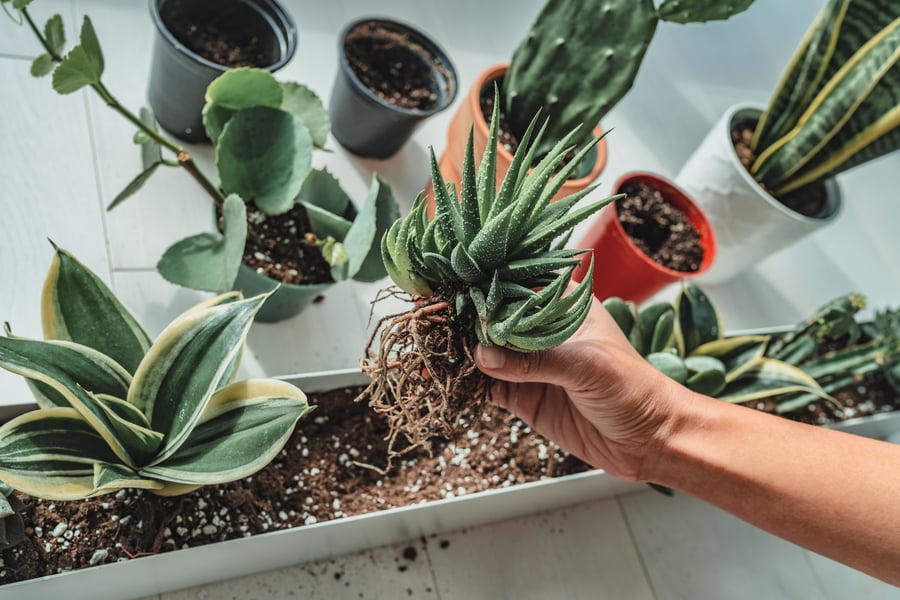There’s nothing more exciting than decorating and styling your home with new plants, and house plants also add a pop of color that other decorative tools lack.
However, plant care is a major factor to consider.
When considering which plants to add to your home, some plants require more drainage than others and can cause a few issues, for example, it can limit the style of plant pot or plant that you’re going to use. Taking care of these plants can also be time-consuming.
While some plants can grow in water (hydroponic plants), most require both air and water to survive and too much water can cause the roots to rot.
Thankfully, some plants don’t require drainage holes when grown in planters. This means you can avoid the arduous task of drilling a drainage hole and cleaning up after water spillage!
Choose from the list below of 7 best plants that don’t need drainage. We’ll also provide you with tips and info on how to care for them!
Top 4 best indoor plants that don’t need drainage
As indoor plants go, there are always a large variety of them to choose from. When considering indoor plants that don’t need drainage that number is reduced a little, but not limited. There’s still a wide variety to choose from.
1. Snake Plants
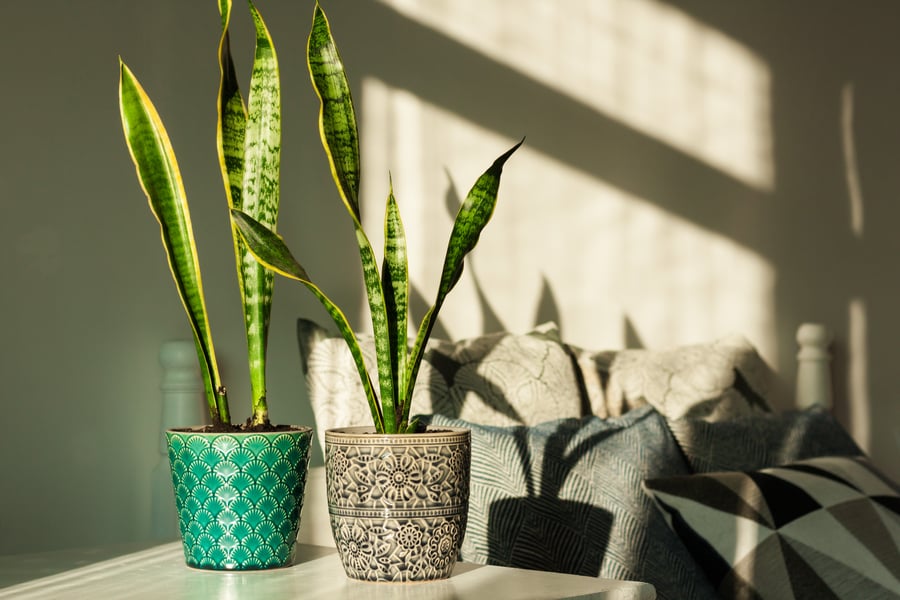
If you’re a beginner at gardening or indoor plants and drainage holes in general, then this plant is exactly for you. It’s the perfect plant for those forgetful types who might not remember to water their plants, or water their plants too much!
Additionally, the Snake Plant can clean the air around us and remove harmful toxins that can make us sick, which makes it ideal if you’re living in a city.
Also known as ‘mother in law’s tongue’ thanks to their blade-shaped leaves, they are tropical houseplants that thrive indoors and in the outdoor garden – perfect for beautiful and unusual containers that don’t need drainage holes.
The Snake Plant also doesn’t require direct sunlight which makes them ideal for the office or any shady part of your living space.
Features of the Snake Plant:
- The snake plant has long, sword-like leaves that grow upright
- It has dark green leaves when it is young which darken even more as it matures
- There’s an outer rim of yellow bordering both sides of the leaves
- They can grow between 3 to 8 feet tall
- They can have a width of 6 inches to 1 foot
Tips and Maintenance:
- They don’t require direct sunlight so avoid leaving them on the window sill.
- It could be best to place your Snake Plant at the south window in your home
- They don’t need drainage and thrive in wet soil
- You should water every 2 to 4 weeks or whenever the soil dries out
- Maintain temperatures of 60 to 80 degrees F
2. Spider Plants
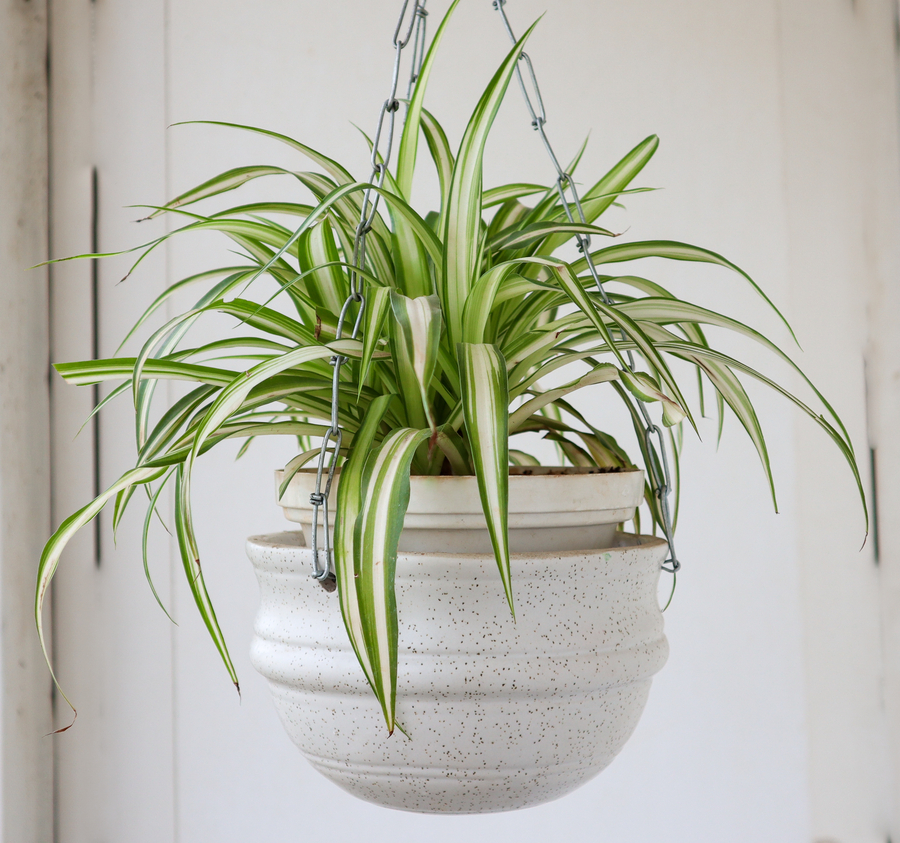
The Spider Plant is perfect for an indoor or outdoor garden, whether you put them in a flowerpot and leave them indoors or in a hanging flower basket and place them outdoors, they’ll be beautiful either way.
Spider Plants originate in tropical islands in West Africa and are perfect for beginners too because they’re easy to maintain and require little work.
Put your Spider plants in well-draining potting soil, without the need of a drainage hole. They can also survive in water containers, but make sure the water is fluoride-free as this can affect the color of the leaves of the spider plant.
Make sure the spider plant gets moderate light, or you can leave it in a bright room but with indirect sunlight.
Features of the Spider Plant
- The leaves are long, narrow and variegated
- The leaves grow up and over creating an elegant arch that resembles a spider
- The leaves have a deep green color in the middle with yellow variegation on the edge of the leaf or “fonds”
Tips and Maintenance
- Spider plants can overgrow their pot which means their roots can push out of the planter. So avoid ceramic planters and stick to fiberglass
- Avoid direct sunlight or the leaves will burn
- Spider plants thrive in temperatures ranging from 50 to 70 degrees F
- Water with clean fluoride-free water to avoid the foliage losing color
- Watering the plants should happen once a week in summer, but make sure the soil doesn’t dry out
3. Chinese Evergreen
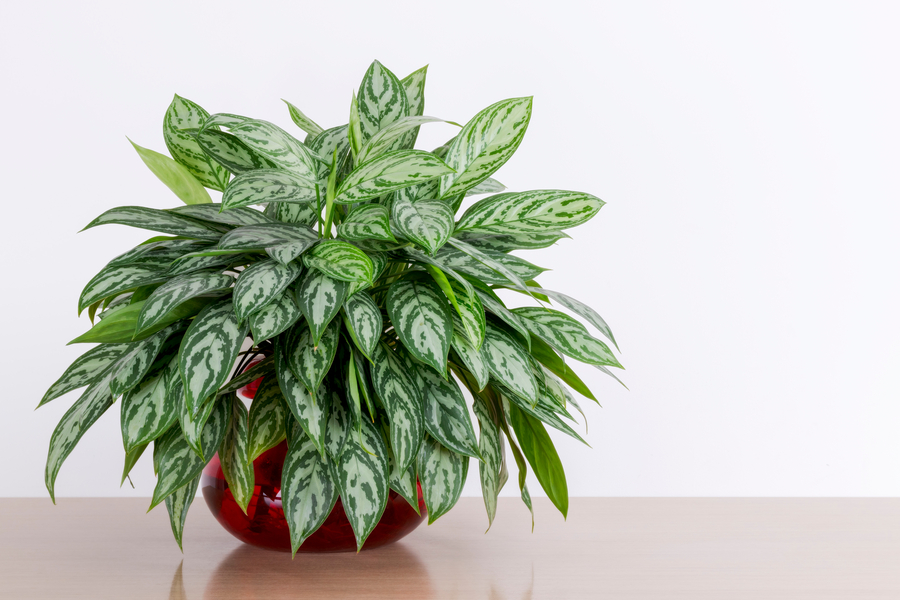
The Chinese Evergreen is a good example of plants that don’t need drainage. It thrives in moist soil, but make sure it’s not soggy. To achieve this get a pot that doesn’t have any drainage holes but be sure not to overwater it.
This is a great choice for beginners because it’s a strong and almost indestructible indoor plant and will bounce back if you forgot to water it.
During the winter months the Chinese Evergreen will lose its color, but not to worry because the color will return again in the Spring and Summer months.
Thanks to the Chinese Evergreen not requiring drainage holes, you can always pot it in beautiful and unique custom planters to give it an extra stylish touch.
It will survive best in medium to low light, so choose a bright room that’s not too sunny. It’s also great at cleaning the air and removing toxins.
As opposed to other indoor plants, these beautiful plants can grow quite tall so they make for a striking feature in your living room or entrance.
Features of the Chinese Evergreen
- They can grow up to 15 feet tall, so consider a corner of the room where it can be placed as a floor plant
- It has dark green to light green leaves with white stripes on them. Occasionally, the they will also have brown edges
- They will lose their color in the colder months, but the vibrant greens will return in the Spring and Summer months
Tips and Maintenance
- They require wet soil, but make sure it’s not soggy
- Don’t overwater the plant as this could lead to root rot
- Watering should happen on average once a week, or check when the soil feels dry
- Note: the leaves are considered toxic to dogs and cats. So keep a watchful eye that they avoid the plant
- They only require medium to low light
- You will need to water more frequently in the warmer month, but make sure you check the moisture of the soil before you do
4. Lucky Bamboo
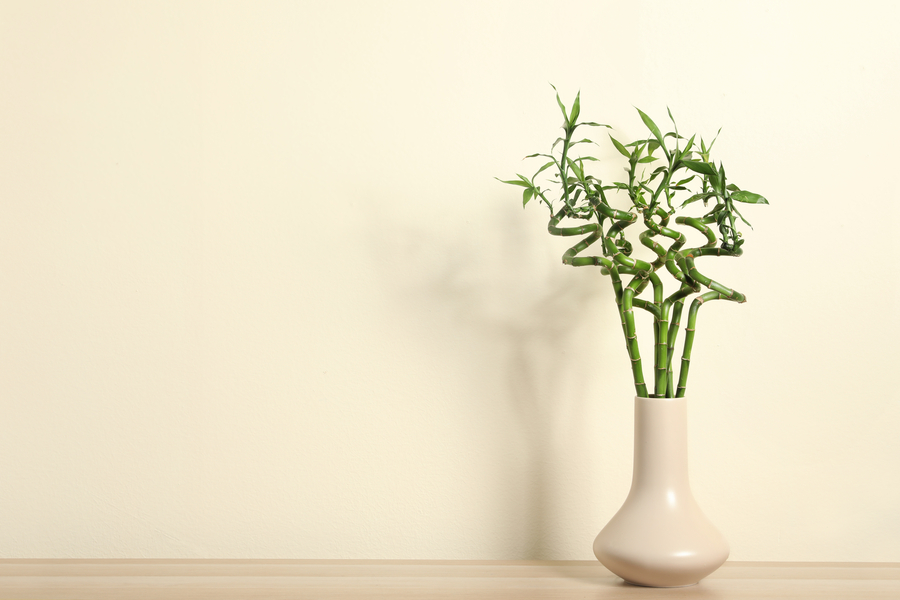
Lucky Bamboo is a unique plant that originates from Central America and doesn’t need soil to grow, you only need water.
These plants are perfect for containers without drainage holes because all that is required is distilled rainwater and you’re good to go, which allows you to become very creative in the process.
You also don’t need to fertilize a Lucky Bamboo, but ensure you keep it in a low light part of your home.
The Lucky bamboo, which isn’t actually a bamboo, is a very good choice for beginners as it has very low maintenance requirements.
Features of Lucky Bamboo
- Lucky bamboo has branches that end in tufts of long, thin leaves
- The outer layer of the stem is strong and dense
- At the same time, the stem is elastic and flexible, which means you’re able to shape it into interesting forms
Tips and Maintenance
- Make sure you change the water every 7 to 10 days, or whenever you see algae forming in the water
- They prefer temperatures between 70 to 90 degrees F
- Make sure you keep it in low light because the more light it receives the faster it will grow
- You can use a wire to shape it and curl it as it grows, however, keep in mind this is not an overnight activity and will take time and a lot of patience
- Warning: Lucky Bamboo is toxic to cats to make sure your plant is out of reach to your house cat.
Top 3 best outdoor plants that don’t need drainage
Decorating the outside of your home will always make your homestead look great and impress the neighbors, however, sometimes the plants you grow can require a lot of work and upkeep to maintain.
So choosing outdoor plants that don’t need drainage is always a better, simpler choice that won’t require much thought but still keep your house looking good. Furthermore, there’s a variety of exciting choices to choose from.
Let’s go through our list of the Top 3 best outdoor plants that don’t need drainage holes and have a look at our tips and maintenance for each one to ensure best results:
1. Pineapple Plant
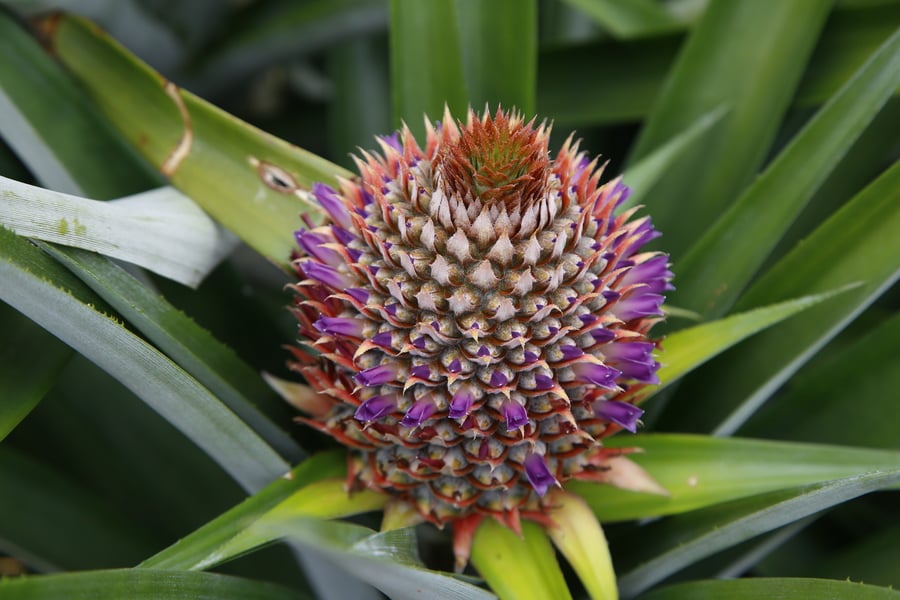
This may come as a surprise to some, but you’re able to grow Pineapples without using drainage holes. The Pineapple plant can also be considered an indoor plant as it can be grown indoors and can survive in a container of water. But ideally, keep it outside because it thrives when receiving a lot of sunshine.
To get started, you don’t even need to buy seeds. You can simply run down to your grocery store and buy a pineapple, then remove the green leaves (also known as the crown). Once the crown has been removed you can start trimming the green leaves individually.
Next, leave the crown in an open container for 5 days allowing the ends of the leaves to harden. Using toothpicks for balance, place the crown over a small bowl of water and watch the new roots start to grow.
Leave the bowl in direct sunlight and the new roots should start showing over a period of 7 – 10 days.
After this, place the newly rooted Pineapple plant in well-drained soil in a container without drainage holes and place it outside to grow, blossom and fruit, then enjoy your tropical plant!
Features of a Pineapple Plant
- They have a rosette of sword-shaped leaves with needle-like tips
- It has a short stout stem
- The leaves are waxy with upturned spines
- The leaves are solid green with red, white or cream stripes
Tips and Maintenance
- In colder months reduce watering
- Leave the container outside so it gets a lot of sunlight
- Check regularly and snip off any dry leaves
- Feed fertilizer every 2 weeks in Spring and Summer and only once a month in Winter and Fall
- They like warm weather, so try and maintain a temperature of 70 to 80 degrees
- Pineapple plants don’t need a lot of watering, so make sure the soil is dry before you water.
2. KupuKupu Fern
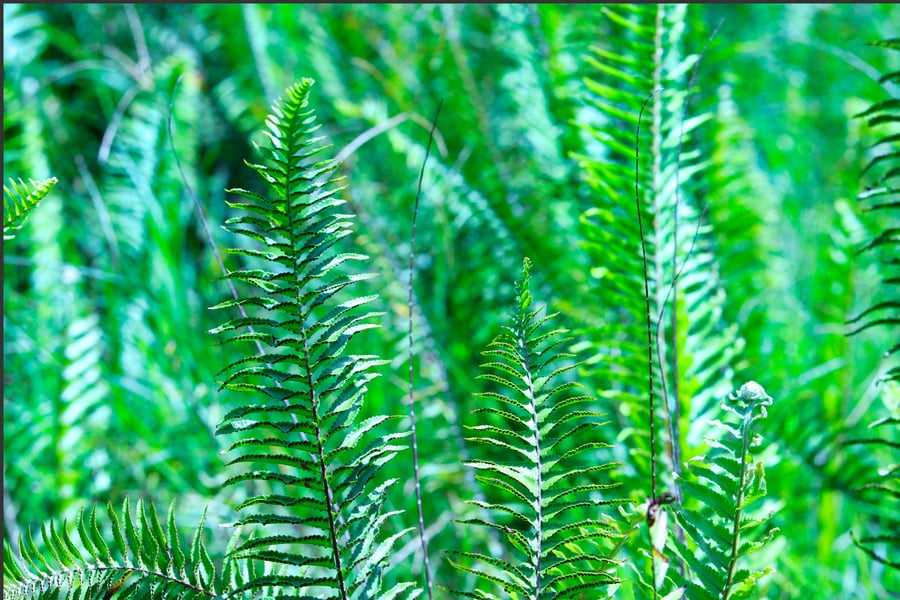
KupuKupu Ferns, also known as Sword Ferns, are tropical plants that originate in Hawaii and are plants that don’t need drainage holes. They’re both outdoor and indoor plants, however, they thrive outdoors in the sunlight.
Due to the size that these ferns can grow to, it’s advisable to stick to one at a time because they are competitive plants and will try and outgrow each other if they’re being grown as an indoor plant. So be aware, they will naturally take up a lot of space.
They don’t require a lot of water, so you don’t need a plant pot with drainage holes. They are also quite easy to maintain and make for a good beginners garden.
Make sure to avoid leaving them in sitting water because this can turn the leaves yellow, which can eventually lead to killing the plant.
Drainage shouldn’t be a problem because these beautiful plants are able to grow on solid walls and trees due to their stolons which develop into tubers underground.
Features of a KupuKupu Fern
- They have fonds that reach skyward and can grow up to 2 feet
- Vivid, bright green stems
- If grown in sunlight the leaves will be brighter green and more rigid
- If they grown in less sunlight the leaves will have a darker green tone
Tips and Maintenance
- They thrive in less water, so only water them about once a week or if the soil is dry.
- It prefers a lot of sunlight, so either leave it outside or in a sunny spot in your home
- Note: Don’t leave it in standing water as this could cause the leaves to yellow
3. Pothos Plants
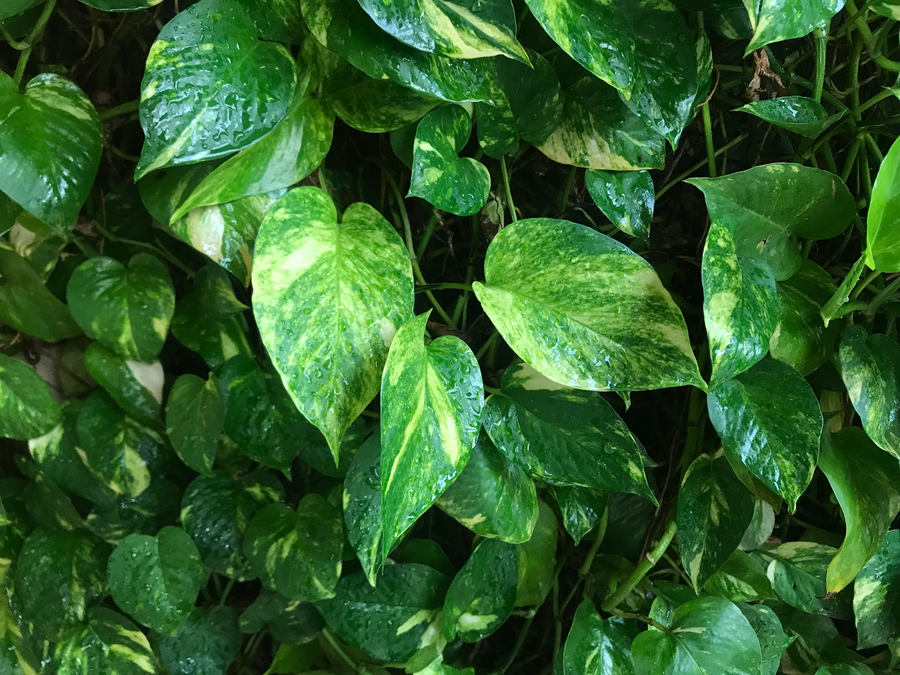
Pothos plants, also known as Devil’s Ivy, are resilient tropical plants that native to South East Asia and French Polynesia and one of the easiest plants to maintain and grow.
Their water needs are really simple so it’s best to get a plant pot without drainage holes. They can also be considered and outdoor and indoor plant. Make sure to keep it in low light conditions for it to thrive because too much sunlight can affect the leaf color.
The only time they will need draining is if you overwatered it.
It gets its name “Devil’s Ivy” because it’s very hard to kill, so that’s saying something.
They’re also really great at cleaning to air in the room and removing harmful toxins like benzen and carbon monoxide.
If you have a black thumb and struggle with growing a garden then this plant is ideal for you to start with.
Features of Pothos Plants
- They have heart-shaped leaves with a deep green color and splashes of white
- They can reach over 10 feet tall
- If they grow outdoors and in sunlight the leave will be a brighter green, whereas, if they’re grown indoor the leaves will have a deeper and darker shade of green
Tips and Maintenance
- Warning: These plants are toxic when ingested, so make sure to keep them away from children and small pets
- If they’re planted in a hanging basket, they can give a great visual effect to the room or space you’re trying to decorate
- They don’t need to be watered regularly. Check when the soil is dry then add water as needed and they will consume all the excess water.
Drainage for Common House Plants
Do Succulents need Drainage?
Succulents are part of the Cacti family, which makes them drought resistant and able to retain water well. Due to this, succulents don’t need a lot of water and can store water easily.
It is ok to water them regularly, but it’s best to avoid doing so.
They will survive in porous, well-draining soil.
Do Snake Plants need Drainage Holes?
Snake plants don’t necessarily need plant pots with drainage holes, however, you need to ensure that you don’t overwater them if you’re using a plant pot without drainage holes.
If there is excess water from overwatering left on the top, this could lead to root rot which will ultimately kill your plant.
So be careful of how much water you feed your plant to avoid catastrophe.
Do Pothos Plants need Drainage Holes?
Like Snake plants, these plants don’t necessarily need plant pots with drainage holes. You need to keep a close eye on how much water you give it to avoid the excess water creating root rot.
Alternatively, get a plant pot that has a singular hole at the bottom to drain out any water that might have accumulated at the top.
Drainage Holes FAQ
What is the best potting soil for pots without drainage?
There’s always a variety of potting soil and choosing the best one for your garden and plants can be a daunting task.
When you’re planning on growing plants without drainage holes the ideal potting soil would be a well-draining porous soil to help with the moisture.
Alternatively, you can always create a drainage layer in your pot and soil by adding a layer of pebbles or stones at the bottom of your pot which allows the water to flow down to the bottom and your plant will use it as needed.
Conclusion
Not all of us have a green thumb and gardening can seem quite intimidating,. However with this list of plants that don’t need drainage you can easily upgrade your home, even if you have a busy lifestyle or, if you’re like most people, quite generous when it comes to watering plants.
By utilizing the list above, not only can you get your new garden started, but you can also invest in a unique and beautiful plant pot that will accentuate your room, or even your home by placing it at your entrance.
If you are a business looking to extend your range of quality planter products, don’t hesitate and get started today by giving us a call, or get a little inspiration and browse our commercial planters.
